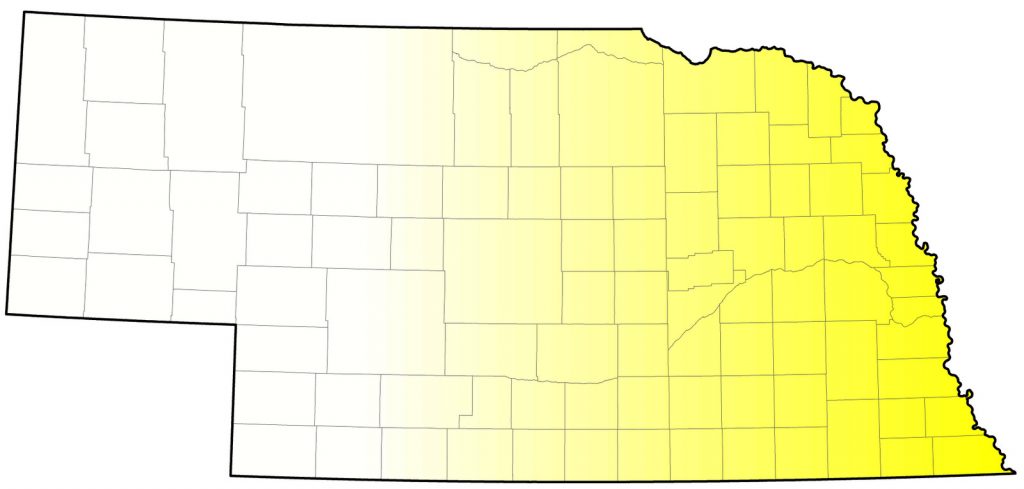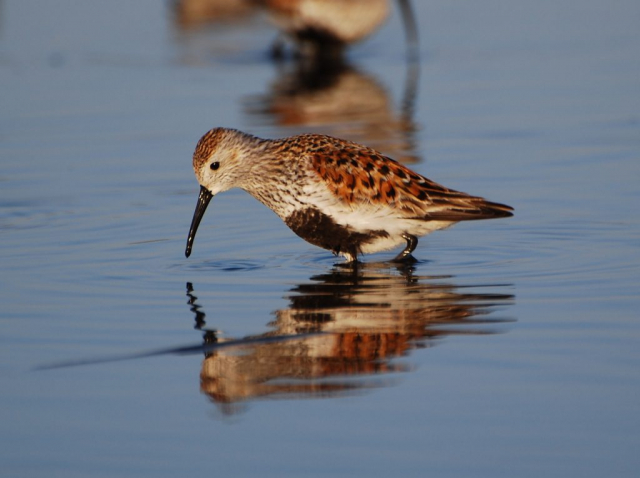Calidris alpina hudsonia
Status: Fairly common regular spring migrant east and east-central, rare casual west-central and west. Uncommon regular fall migrant statewide. Rare casual winter visitor statewide.
Documentation: Specimen: UNSM ZM12675, 14 Oct 1890 Lancaster Co.
Taxonomy: AviList (2025) recognizes 10 subspecies, seven of which are Eurasian breeders. In North America, arcticola breeds in northwest Alaska and northwest Canada north of the Lisburne Peninsula and winters in Asia, pacifica breeds in western and southern Alaska, wintering on the Pacific Coast of North America, and hudsonia breeds in central Canada (Nunavut to Ontario) and winters in the southeastern United States.
Unlike North American subspecies, whose adults molt on the breeding grounds and thus are in fresh basic plumage during fall migration, Eurasian subspecies do not molt on the breeding grounds, and thus are in worn alternate plumage in fall.
Based on distributional data, Nebraska Dunlin are presumed hudsonia.
Spring: Apr 2, 2, 3 (Jorgensen 2012) <<<>>> May 29, 29, 30
Earlier dates are 17 Mar 2012 Keith Co, 19 Mar 2017 Phelps Co, 21 Mar 2009 eastern Rainwater Basin, and 30 Mar 2024 Lancaster Co.
Later dates are 2 Jun 2018 Phelps Co, 2 Jun 2021 Clay Co, 2-3 Jun 2022 Smith Lagoon WPA, Clay Co, 4 Jun 2024 Dakota Co, 5-11 Jun 2005 Freeman Lakes WPA, York Co, and 11 Jun 2000 45 at Funk WPA, Phelps Co.
A few Dunlin arrive in Apr, but most move through in May. Peak counts occur in late Apr and the first half of May.
There are only a few west and west central reports: 18 Apr 1986 Keith Co (Rosche 1994), 19 Apr 1987 Garden Co, 21 Apr 2024 Scotts Bluff Co, 24 Apr 1999 Lake McConaughy, Keith Co, 26 Apr 2025 Sheridan Co, 11 May 2013 Scotts Bluff Co, 11 May 2022 Scotts Bluff Co, 13 May 2004 Lake McConaughy, 18-19 May 1983 Dawes Co, 18 May 1985 Garden Co (Rosche 1994), 20 May 2016 Box Butte Co, 23 May 1939 Logan-Lincoln Cos., and 25 May 2025 Lake Ogallala, Keith Co.
- High counts: 350-400 near Niobrara, Knox Co 24-25 Apr 2013, 235 in the eastern Rainwater Basin 17 May 2007 (including 133 at Renquist Basin WMA, York Co), and 70 there 16-18 May 1997.
Fall: Oct 18, 19, 20 <<<>>> Nov 8, 9, 10
Earlier dates are 29-31 Jul 2008 Sarpy Co (Clem Klaphake, personal communication), 3 Sep 2021 Keith Co, 4 Sep 2002 two Lancaster Co, 12 Sep 2019 Lancaster Co, 22 Sep 2023 Lancaster Co, 24 Sep 2023 Hall Co, 27 Sep 2020 two Sarpy Co, 6 Oct 2018 Polk Co, 15 Oct 2007 Lancaster Co, and 15-16 Oct 2023 Lancaster Co.
Later dates are 22 Nov 2022 Saunders Co, 30 Nov 2007 Keith Co, and 30 Nov 2021 Platte Co. There are four later records; see Winter.
Reports before Oct are unexpected, as, unlike other long-distance migrants of the genus, there is no early movement of adults; adults and young birds migrate together after all have completed molting (Holmes 1966).
The major movement of Dunlin is during the latter half of Oct, although numbers are significantly lower than in spring (see High Counts). Two of the reports during the peak period are specimens taken in Lancaster Co, one a molting adult taken 14 Oct 1890 (cited above) and the other a juvenile molting to first basic taken 20 Oct 1917 (UNSM ZM6170).
- High counts: 24 in Clay Co 10 Oct 1998 (Jorgensen 2012), 17 at Branched Oak Lake, Lancaster Co 2 Nov 2023, and 10 at Cunningham Lake, Douglas Co 25 Oct 1996.
Winter: There are four reports. One was photographed at Lake Ogallala, Keith Co 9-31 Dec 2011, probably the same bird observed there 17 Mar 2012, two were at Harlan County Reservoir, Harlan Co 14 Dec 2023, one was present 6-23 Jan 1981 at North Platte NWR, Scotts Bluff Co, and one was with at least 18 Killdeer below Lake Ogallala 8 Jan 2022.
Dunlin are rare northward on the Great Plains in winter (Dec through mid-Mar). Along with the three Nebraska records, the northernmost are one in northwestern Iowa Feb 1998 and one in northeastern Colorado Feb 2009 (eBird.org, accessed Oct 2023).
Images
Abbreviations
NWR: National Wildlife Refuge
UNSM: University of Nebraska State Museum
WMA: Wildlife Management Area (State)
WPA: Waterfowl Production Area (Federal)
Literature Cited
AviList Core Team, 2025. AviList: The Global Avian Checklist, v2025. https://doi.org/10.2173/avilist.v2025.
Holmes, R.T. 1966. Breeding ecology and annual cycle adaptations of the Red-backed Sandpiper (Calidris alpina) in northern Alaska. Condor 68: 3-46.
Jorgensen, J.G. 2012. Birds of the Rainwater Basin, Nebraska. Nebraska Game and Parks Commission, Lincoln, Nebraska, USA.
Rosche, R.C. 1994. Birds of the Lake McConaughy area and the North Platte River valley, Nebraska. Published by the author, Chadron, Nebraska, USA.
Recommended Citation
Silcock, W.R., and J.G. Jorgensen. 2025. Dunlin (Calidris alpina), Version 1.0. In Birds of Nebraska — Online. www.BirdsofNebraska.org
Birds of Nebraska – Online
Updated 10 Jul 2025

